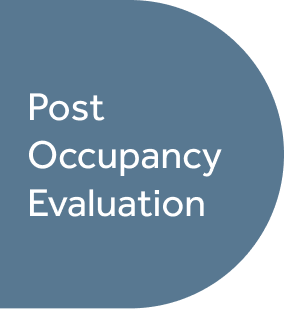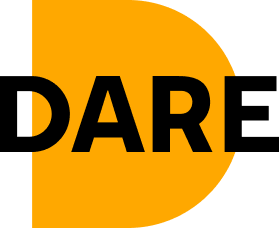04 After DARE
On average office-based employees lose 86 minutes a day due to distractions.13
Support
The level of distraction in a new office can be even greater as everything is new and unfamiliar. This can be further exacerbated when things don’t work as expected. When our clients move into an office that we design we are on hand to support the transition from old space to new space.
At Dare, our support service starts before the move we can create workspace intro to help staff familiarise themselves with the new features. We can undertake orientation tours or organise demos and training. We customise this service to each client and even to each group of users to ensure a seamless adaptation to the new space.
When things do go wrong or don’t work as expected we are available to help resolve such issues, whether they occur the week you move or several months or years later we are always available to support you and to ensure your workspace is working for your business this can include:
- troubleshooting systems;
- identifying why spaces are underutilised and adjusting them;
- arranging training and refresher courses for employees;
- preparing quick reference guides;
- reprogramming systems to make them easier to use;
- adjusting lighting;
- testing the acoustic performance of spaces.
If your workspace is causing inconvenience, then call us we are here to support you and ensure your workspace is the best it can be.
13Research Gate
Most companies spend between 20-30% of their annual revenues on people compared to 10-20% on providing physical workspace and 4-6% on Technology.
Post Occupancy
Evaluation
Almost all companies undertake employee performance reviews on at least an annual basis. Considering that the spend on the workspace (combining physical and digital) is almost the same as on people. Should you be evaluating the performance of your workspace?
At Dare, we believe that if your workspace is operating at optimum potential, it can make a huge contribution to your business. It can impact everything from customer perception to employee productivity and creativity. We work with our clients to develop unique performance analyses tailored to our clients’ specific requirements and their workspaces.
When you move into a new space it is just as important that you evaluate if it performs in the way you had envisioned, much like a probation review with an employee your new workspace can be assessed. It is easy to measure things like energy consumption, air quality etc. However, we focus on evaluating the spatial experience and how it contributes to the performance of your business.
Our post occupancy evaluation is designed to:
- evaluate how employees feel about the workspace;
- help you understand the spaces that work for your business and those that don’t;
- identify utilisation patterns so that the space can be optimised;
- identify any issues that impede employee interaction, creativity and productivity;
- provide recommendations for measures that can be taken to further improve workspace performance.
You spend almost as much on your workspace as you do on your people you should expect the space to work as hard as your employees and contribute as much to your business.
04
After DARE

On average office-based employees lose 86 minutes a day due to distractions.13
The level of distraction in a new office can be even greater as everything is new and unfamiliar. This can be further exacerbated when things don’t work as expected. When our clients move into an office that we design we are on hand to support the transition from old space to new space.
At Dare, our support service starts before the move we can create workspace intro to help staff familiarise themselves with the new features. We can undertake orientation tours or organise demos and training. We customise this service to each client and even to each group of users to ensure a seamless adaptation to the new space.
When things do go wrong or don’t work as expected we are available to help resolve such issues, whether they occur the week you move or several months or years later we are always available to support you and to ensure your workspace is working for your business this can include:
- troubleshooting systems;
- identifying why spaces are underutilised and adjusting them;
- arranging training and refresher courses for employees;
- preparing quick reference guides;
- reprogramming systems to make them easier to use;
- adjusting lighting;
- testing the acoustic performance of spaces.
If your workspace is causing inconvenience, then call us we are here to support you and ensure your workspace is the best it can be.
13Research Gate

Most companies spend between 20-30% of their annual revenues on people compared to 10-20% on providing physical workspace and 4-6% on Technology.
Almost all companies undertake employee performance reviews on at least an annual basis. Considering that the spend on the workspace (combining physical and digital) is almost the same as on people. Should you be evaluating the performance of your workspace?
At Dare, we believe that if your workspace is operating at optimum potential, it can make a huge contribution to your business. It can impact everything from customer perception to employee productivity and creativity. We work with our clients to develop unique performance analyses tailored to our clients’ specific requirements and their workspaces.
When you move into a new space it is just as important that you evaluate if it performs in the way you had envisioned, much like a probation review with an employee your new workspace can be assessed. It is easy to measure things like energy consumption, air quality etc. However, we focus on evaluating the spatial experience and how it contributes to the performance of your business.
Our post occupancy evaluation is designed to:
- evaluate how employees feel about the workspace;
- help you understand the spaces that work for your business and those that don’t;
- identify utilisation patterns so that the space can be optimised;
- identify any issues that impede employee interaction, creativity and productivity;
- provide recommendations for measures that can be taken to further improve workspace performance.
You spend almost as much on your workspace as you do on your people you should expect the space to work as hard as your employees and contribute as much to your business.

